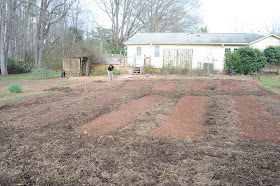We do compost three ways, passive, more passive and very passive. We do not turn or fuss with the compost pile, that job belongs to the microbes, mycelium and earthworms. There are way too many other things to do to spend much time pampering the compost pile! We have rich black compost, full of earthworms and friable dark soil in the gardens, so for us passive composting works just fine! The key is patience. With time the earth will works it's wonders and will provide beautiful, earthworm filled compost, so that you can give your garden all it needs to grown healthy, nutritious food. Our soil is so rich that it has been years since we have added and manure to our established beds. New beds of course, need a little help since the soil is not conditioned yet. My husband jokes that he is literally farming dirt. We introduce so much compost to our garden beds that they need to be carved down periodically and the soil moved elsewhere.
For our passive vegetable garden compost pile we build a cinder block box on the ground, and start putting in kitchen scraps and grass clippings. I am vegan (really "plant based" not vegan, since I eat honey...) so we put all our kitchen scraps, including prepared foods that have gone south in the fridge in the passive compost pile since there are no animal products prepared in our home. If your prepared food contains animal products, don't put prepared foods in the compost. It will draw vermin. Once there is a nice thick layer of kitchen scraps, etc in the compost bin we toss a layer of soil from a dirt pile we keep close by on the scraps to keep down the smell.
 |
| This is our recently built veg garden compost pile. The layer of scraps was covered with a little dirt after this photo to keep the odor down and discourage flying insects. |
Since we produce so many veg and fruit scraps from what we consume daily, it pretty much gets covered every day or two. We don't put leaves in this compost because the majority of the tree we have in the yard are Shingle Oaks and their thin waxy leaves don't break down fast enough to suit me. We save or leaves for our "very passive" compost. As the layers of kitchen scraps and soil grow we add rows of blocks to our compost pile. When it reaches about 4 feet high, we cover the top of the pile with a tarp to keep the rain from leaching out the nutrients. In a week or so the top layer of scraps will be consumed by the earthworms and the pile is ready for use to top dress our vegetable beds.
 |
| This is a finished compost bin. It is built into a slope so the front is short but the body of the bin is 4 ft. deep. |
Then we start another pile. We move these piles around the garden since the soil underneath a compost pile becomes very fertile. This way we feed the ground while making compost to feed more ground.
The "more passive" composting is done in the pathways between the between our French Intensive Raised Beds. We double dig our raised beds to about 18" and remove the soil.We then use a pitchfork to break up the soil at the bottom to another foot. after which we amend the removed soil with manure, peat, sand and compost (for newly formed beds) and put the soil back in the beds.
 |
| Here are some of the amended beds before the mulch is brought in. The mulch will reach to just below the tops of the beds once it settles. |
 |
| The new beds and the pathways between them are now ready for spring! |
Our last composting method has been dubbed Very Passive Composting. This compost pile has been in the works since 1989 when Hurricane Hugo played Pick Up Sticks with the trees on our land. We started dragging tree branches and rolling snapped off and splintered tree trunks into a depression in the woods. In subsequent years we hauled tarps full of fall leaves back there and dumped them on the pile of downed tree debris. Ice storms and tornadoes added to the mounting pile of wood back in the woods. We have continued to drag and dump all of our tree debris and leaves for 30 years. The pile is now a land mass.... about 30 feet long, 20 feet wide and in places 10 or more feet deep.
 |
| This is a view of the back of the Very Passive compost pile. It is at least 10 feet deep, probably more. |
 |
| Here is a view of part of the top of the pile. |
The pile has grown huge and then broken down over and over until it is mostly black soil all the way to the bottom of the pile.
 |
| This compost is like black gold. Soft, friable and full of life. |
We use this compost for dressing around our landscaping and for filling in and leveling places in the yard. We don't usually use this in the veg garden simply because we don't need it there. We produce so much kitchen compost that we usually use that to feed the vegetable garden and leave the other for "terra-forming" projects and landscaping.
So in a nutshell, composting requires very little work and a provides a whole lot of benefit to both food gardens and ornamental gardens and landscaping. There are other kinds of composting but these have worked out best for us. What kind of composting do you use? Please feel free to share your experiences and techniques!




No comments:
Post a Comment